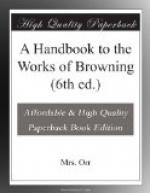In Mr. Browning’s expanded version, the love is returned, and the lovers determine to fly together. But each day brings fresh motives for postponing the flight, and each day they exchange glances with each other—he passing by on his horse, she looking down from her window—and comfort themselves with the thought of the morrow. And as the days slip by, their love grows cooler, and they learn to be content with expectation. They realize at last that the love has been a dream, and that they have spent their youth in dreaming it; and in order that the dream may continue, and the memory of their lost youth be preserved, they cause, he his statue to be cast, she her bust to be moulded, and each placed in the attitude in which they have daily looked upon each other. They feel the irony of the proceeding, though they find satisfaction in it. Their image will do all that the reality has done.
Mr. Browning blames these lovers for not carrying out their intention, whether or not it could be pronounced a good one. “Man should carry his best energies into the game of life, whether the stake he is playing for be good or bad—a reality or a sham. As a test of energy, the one has no value above the other.”
He leaves the “bust” in the region of fancy, by stating that it no longer exists. But he tells us that it was executed in “della Robbia” ware, specimens of which, still, at the time he wrote, adorned the outer cornice of the palace. The statue is one of the finest works of John of Bologna.
The partial darkening of the Via Larga by the over-hanging mass of the Riccardi (formerly Medici) Palace[63] is figuratively connected in the poem with the “crime” of two of its inmates: the “murder,” by Cosimo dei Medici and his (grand) son Lorenzo, of the liberties of the Florentine Republic.
The smallness of this group, and its chiefly dramatic character, show how little direct teaching Mr. Browning’s works contain. There is, however, direct instructiveness in another and larger group, which has too much in common with all three foregoing to be included in either, and will be best indicated by the term “critical.” In certain respects, indeed, this applies to several, perhaps to most, of those which I have placed under other heads; and I use it rather to denote a lighter tone and more incidental treatment, than any radical difference of subject or intention.
CRITICAL POEMS.
“Old Pictures
in Florence.” } Dramatic Lyrics.
“Respectability.”
} Published in “Men
“Popularity.”
} and Women.”
“Master Hugues
of Saxe-gotha.” } 1855.
“A Light Woman.”
Dramatic Romances. Published in “Men and
Women.”
1855.
“Transcendentalism.”
("Men and Women.”) 1855.
“How it Strikes
a Contemporary.” ("Men and Women.”) 1855.
“Dis aliter Visum;




